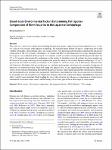Item Infomation
Full metadata record
| DC Field | Value | Language |
|---|---|---|
| dc.contributor.author | Itsukushima, Rei | - |
| dc.date.accessioned | 2023-08-14T04:27:02Z | - |
| dc.date.available | 2023-08-14T04:27:02Z | - |
| dc.date.issued | 2023 | - |
| dc.identifier.uri | https://link.springer.com/article/10.1007/s12237-023-01248-0 | - |
| dc.identifier.uri | https://dlib.phenikaa-uni.edu.vn/handle/PNK/8799 | - |
| dc.description | CC-BY | vi |
| dc.description.abstract | This study was conducted to clarify the relationship between fish species composition and environmental factors at various scales in river estuaries in the Japanese archipelago. The estuaries harbor diverse fish species composition due to their complex topography, varied climatic zones, and ocean currents. Non-hierarchical cluster analysis classified the fish species composition of 100 river estuaries (58 families, 152 species, and 486,356 individuals) into five groups. The highest number of species was confirmed in the group of river estuaries located in southwestern Japan and flowing into the inner bay (55.1 ± 9.6 species), characterized by an abundance of the number of Gobiidae species. In contrast, the species number was the lowest in the groups consisting of river estuaries that primarily belong to the northern Japanese archipelago (15.3 ± 3.3 species) that were characterized by an abundance of the number of cold-water fishes such as Salmonidae, Pleuronectidae, and Osmeridae. | vi |
| dc.language.iso | en | vi |
| dc.publisher | Springer | vi |
| dc.subject | Broad-Scale Environmental Factors | vi |
| dc.subject | Japanese Archipelago | vi |
| dc.title | Broad-Scale Environmental Factors Determining Fish Species Composition of River Estuaries in the Japanese Archipelago | vi |
| dc.type | Book | vi |
| Appears in Collections | ||
| OER - Khoa học môi trường | ||
Files in This Item:

